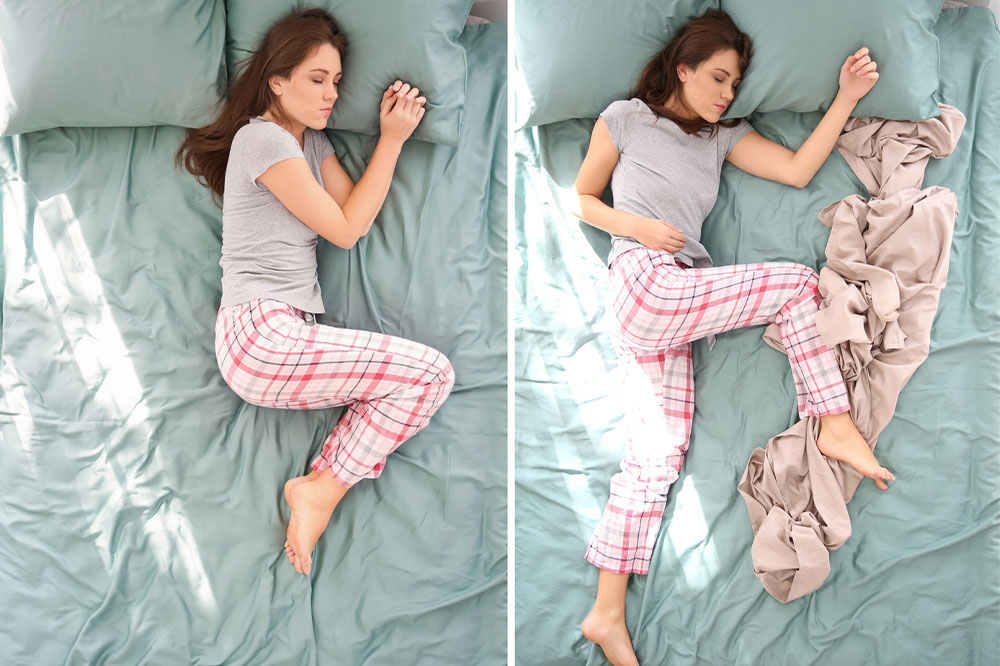Effects of Sleeping Positions on Sleep

Sleep is an essential part of daily routine. As you rest and relax during the night, the body carries out repair and restoration processes to help you stay healthy. The position and level of comfort while asleep can affect this process. Certain sleeping positions may cause or worsen pain, exert stress on the spine, or increase stiffness in the back. Here is a look at how sleeping positions can affect sleep:
Finding the best sleeping position
When it comes to sleep, there is no one-size-fits-all solution. Your ideal sleeping position depends on factors such as your health, lifestyle, spinal alignment, and comfort. However, sleeping on the back or side is generally considered more beneficial than sleeping on your stomach. This is because your spine is better supported and balanced in the former, making room for pressure relief and muscle relaxation.
Sleeping on your side
A whopping 60% of adults sleep on their sides. For children, it is common to alternate between different sleeping positions, but as the flexibility of the spine decreases, there is a clear preference for side sleeping. Sleeping on the side is associated with several health benefits, like promoting healthy spinal alignment, reducing pain in the neck and the back, and decreasing the risk of heartburn and snoring. This makes the position popular among pregnant women and others with acid reflux, back pain, and sleep apnea. For ideal spine alignment, doctors recommend using a pillow or a blanket between your knees and a thicker pillow that matches the distance between your neck and your shoulder under your neck.
According to experts, sleeping on the side with a well-supported spine is beneficial for pregnant women as it relieves the pressure on the belly. This also improves blood circulation in the body. Ideally, sleeping on the left side facilitates blood flow to the fetus, uterus, kidneys, and heart. Placing pillows under the belly, between the legs, and at the lower back can help make this position more comfortable. It is also important to note that sleeping on one side for too long can cause shoulder pain. To avoid this, it is recommended to shift positions occasionally and use a high-quality pillow and mattress.
Sleeping on your back
Around 30% of people prefer sleeping on their backs. It is a wonderful sleeping position to align the spine and reduce the risk of aches in the neck and back. Sleeping on the back in a slightly upright position can also help relieve congestion in the nose. It is particularly helpful for those with lumbar spinal pain, neck pain, and congestion and those who are concerned about the appearance of wrinkles. Sleeping on the back is not ideal for older people, pregnant women, people with sleep apnea, GERD, acid reflux, or snoring problems.
Instead of lying flat on the back, using a memory foam pillow or a pillow with a divot can help support the neck and prevent the risk of misalignment. As an alternative, placing a rolled towel underneath the neck can also help. Another aspect to take into consideration when sleeping on the back is hand placement. For instance, sleeping with your hands to the side is considered more beneficial in comparison to placing one hand on the forehead. This is because it may cause unevenness in the spine, which may lead to shoulder or neck pain.
Sleeping on your stomach
When it comes to sleeping positions, sleeping on the stomach ranks last on the list. According to research, less than 10% of the population sleeps in this position. Although it can help reduce snoring and sleep apnea by opening up the airway, it puts unnecessary pressure on the neck and back, leading to an ache. It may lead to waking up feeling sore or tired, despite having slept for 7 to 9 hours. As there are several concerns related to sleeping in this position, pregnant women and those with neck and back problems must avoid sleeping on their stomachs. If you are keen on sleeping on your stomach, try placing a pillow under your abdomen to allow the natural curvature of your spine. You can also try sleeping with a thin pillow (or no pillow at all) to reduce any strain on your back.
Tips for improving sleep quality
A good night’s sleep is not determined by sleeping position alone. There are several factors influencing it, such as the mattress, location of the bed, pillows, sheets, and even blinds. Here is how you can optimize your bedroom for a good night’s sleep:
Use clean sheets: Wash and dry your sheets frequently. This will help you remove any dust or allergy-causing particles that may disrupt your rest.
Get blinds: Invest in top-notch blinds or curtains. When sleeping, keep them closed to keep the room dark and promote sleep.
Check your bed position: Position your bed in such a manner that you do not experience any distractions.
Put your phone away: According to research, late-night use of phones and other devices can impact the quality of your sleep. So, put your devices away or leave them in another room at least one hour before bed.
Choose the right mattress: Based on your sleeping position, some mattresses may provide better comfort and improve spinal alignment to enhance sleep quality. Here are a few things to consider:
- A firm or hybrid mattress (combination of coils and foam) is suitable for back sleepers as it helps provide proper spinal support.
- As sleeping on the side puts pressure on the shoulders and the hips, a softer mattress can help alleviate the strain. Memory foam mattresses or pillow-top mattresses may be ideal for side sleepers.
- For stomach sleepers, it is important to find a mattress that firmly supports the spine. If you sleep on your stomach, consider investing in a firm hybrid or foam mattress, as it can help reduce pain and stiffness while providing ample comfort.









